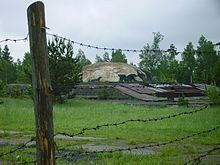 | ||
Plokštinė missile base (Lithuanian: Plokštinės raketų bazė) was an underground base of the Soviet Union. It was built near Plokščiai village, 13 kilometres (8.1 mi) north of Plungė, in sparsely populated Plokštinė forest near Plateliai Lake, Samogitia, Lithuania. This is the first nuclear missile base of the Soviet Union, an underground R-12 Dvina ballistic medium-range missile base. In 2012, the Cold War Museum was opened at the site.
Contents
The site appears to have been operated by the 79th Guards Missile Regiment, part of the 29th Guards Rocket Division.
Construction
At the time when the United States started building underground military bases, it was decided that the Soviet Union had to maintain its military advantage. Therefore, in September 1960, the Soviets started rapid construction of an underground military base, one of the first in the Soviet Union, near the village of Plokščiai. The chosen location was 160 metres (520 ft) above sea level and it could cover all of Europe, including Turkey and southern European countries. In addition, the soil was easy to excavate and the local population was small. There were no bigger towns or villages nearby, just isolated houses whose inhabitants were paid 4,500 rubles to relocate.
In 1960, more than 10,000 Soviet soldiers started secret works in the Žemaitija National Park that took two years. The costs of construction were comparable to the costs of building a city district or a small town.
Operation
The base was one of the top Soviet military secrets that was revealed by U.S. reconnaissance only in 1978. The Plokštinė nuclear missile launch site started operating around three years after it was established.
The base boasted of a network of tunnels and included four deep shafts that have a depth between 27 to 34 meters. They were covered by concrete domes that could be moved aside on rails in 30 minutes. The base could stay autonomous for 15 days, or for 3 hours if also hermetically sealed. The surrounding electric fence was normally connected to 220 V, with a possibility to raise the voltage to 1700 in case of alert. The active team consisted of about 300 people, most of them military guards.
The base included four silos that housed R-12 Dvina missiles with nuclear warheads. These missiles were propelled using a medium-range liquid. They weighed more than 40 tons, including 1,500-kilogram (3,300 lb) warhead. These surface-to-surface missiles had a range of a little less than 2,500 kilometres (1,600 mi). No missiles, even for tests, were launched from the base. Thanks to USSR-USA agreements, launching a rocket required near simultaneous turning of the two different keys by the two operators.
After decommissioning
After twelve years of operations, the site was shut down. Since the collapse of the Soviet Union, the site has been abandoned and not maintained. It has been visited by urban explorers, also suffered from numerous metal thefts. After the reconstruction in 2012, the former base site now hosts the Cold War Museum, opening one of the four existing silos for visitors.
